Flowering annuals for autumn and winter
When rains fall on soil that is still holds autumn’s warmth, it is generally a great time for planting. Flowering annuals can establish their roots in readiness for winter and spring flowering.
In warmer climates the autumn planting season extends into June, and some flowers can be planted all year round in a frost free climate. In cooler climates seeds are best sown earlier, in February or March. In really cold climates delay planting frost tender varieties until spring, when the risk of frost has passed.
Many gardeners opt to bypass the seed sowing stage and purchase seedlings ready to plant. ’Potted colour’ is the name given to advanced seedlings which are already flowering with their roots well developed in a pot of their own. These plants cost more but are less likely to suffer transplanting shock.
Fill pots and hanging baskets:
Pansies
Pansies flower and flower, starting in autumn, through winter and spring and into summer. They come in just about every colour, even black and are a favourite choice for pots, hanging baskets, window boxes or garden borders. They perform best in a well drained soil or potting mix with fertiliser. Protect from snails. If autumn planted pansies get tatty over winter, trim them back and feed them with liquid fertiliser and a fresh crop of flowers will appear. Traditionally they are not for hot weather, but modern strains are increasingly heat tolerant.
Polyanthus
Super colourful polyanthus (Primula acaulus) offer a vast choice of colours and forms and are a top choice for winter pots. Snip of spent flowers and feed every few weeks and they’ll bloom for months on end.
Lobelia
Lobelias produce teaming masses of small blue, white, purple, pink, or red flowers on plants which vary from cascading to mounding to upright. Cascading forms are great for hanging basket while those with a compact mounding habit make colourful edging. Among the very of the best of the blues.
Alyssum
Dainty alyssum will flower all year round in a mild climate, self sowing to renew its fragrant clumps. It is ideal for growing in and around paving. Alyssum grows in full sun or part shade and survives periods of drought and poor soil, but doesn’t take kindly to cold wet conditions. Flowers are white, cream, pink, purple, red or apricot shades. Alyssum is a good companion flower for bulbs, herbs and veges in pots, a great mixer in a hanging basket and a useful border.
Plant with spring flowering bulbs:
Fairy primrose
Fairy primrose (Primula malacioides) are perfect for planting with bulbs and for mass planting in drifts of airy colour around trees and shrubs, blooming in winter and spring. Tiered flowers in shades of pink, purple and or white sit above rosettes of soft green leaves. Nice in pots too.
Forget-me-not
Considered a weed by many, dainty forget me not (Myosotis sylvatica) is a very successful self seeder, so that once you have it in your garden you may not need to plant again to enjoy the pretty blue haze right through spring. But after flowering, the spent plants are easy to pull out. They are ideal as shade fillers under trees and as companions for spring flowering bulbs. As well as blue, there is pink and white. Sow directly into the ground or plant seedlings.
Viola
Violas are baby pansies. What they lack in size they flowers more than make up for in volume, smothering the plants from early spring. Being tidy compact habit and low growing they are the perfect border in containers or in the garden. They are ideal for planting with bulbs. Violas are easy to grow in sun or semi-shade, from autumn to summer. They will perform best in a well drained, compost-rich soil with occasional liquid feeding.
Grow especially for picking:
Iceland poppy
Lovely for picking, Iceland poppies (Papaver nudicaule) have delicate, cup shaped flowers with petals like crumpled silk in a range of beautiful colours in the cream-yellow-orange spectrum. Their slender stems and flower buds are covered in silky hairs which along with the flowers glisten in the late winter sun. They will grow in any climate but are at their best in a cool climate. In very cold climates plant in spring for summer flowering. To prolong flowering, remove spent blooms or pick for indoors. Pick flowers in the early morning and dip in boiling water for 30 seconds.
Sweet peas
Sweet peas, loved for their fragrance and beautiful for picking, are sown in autumn to flower in spring, or in spring to flower in summer. They need something to climb on, such as a tepee made from bamboo stakes and are best sown directly into well prepared ground. Give them a well drained compost rich soil and feed them generously once they start to grow with liquid fertiliser. Mulch is a good idea to keep roots cool. They will flower 12 to 15 weeks after sowing.
Stock
Stock (Mattholia incana) is loved for its fragrance, which is best at night or on overcast days. These are cool season flowers in shades of pink, purple, red, white or cream. There are both single and double flowers and tall or dwarf forms. Plant seedlings from autumn to early spring in a well drained fertile soil.
Brighten the winter vege patch:
Calendula
Bright yellow or orange, calendulas are a welcome sight in late winter. Among the easiest of annuals to grow, calendulas look wonderful in herb and vege gardens where they repel insect pests and add a splash of contrasting colour. The petals are edible and can be sprinkled on cakes or salads.
Ornamental kale
These decorative cabbages are available in gorgeous shades of pink, green and creamy white. They may be grown in containers or in the garden soil. If the seedlings are planted closer together, the heads will be smaller with stems long enough for picking.
For that ‘wildflower’ effect in spring:
Poppies
Soldier poppies (Papaver rhoeas) aka Flanders poppies, and their multi-coloured offspring the Shirley poppies put on a fabulous ‘wild-flower’ show in spring when planted en masse. Both can be grown from seed sown directly into well drained garden soil or planted as seedlings in spring. They like full sun but prefer the cooler temperatures of spring to high summer.
Taller growing oriental poppies (Papaver orientale) produce fat flower buds that open to large double or single blooms in a wide range of colours. In warm winter climates oriental poppies are short lived, behaving more like annuals than the true perennials they are. However, like most poppies they will often self sow and pop up the following year.
Californian poppy
This long flowering Californian wildflower (Eschscholtzia) produces attractive lacy foliage, a low spreading habit and myriads of satin textured poppy flowers. It’ll grow in poor soil and tolerate dry conditions with self seeding as a bonus. Bright orange is the most well known colour, but there are many other colours to choose from.
Cornflower
Cornflowers are loved for their intense blue colour. There are also pink and white, tall or dwarf. Easy to grow in full sun, cornflowers are cool weather flowers ideally sown or planted in autumn (or early spring in a cold climate).
Cosmos
Tall frilly cosmos flowers are white, pink or purple. Great for picking and for long season garden display, these dahlia relatives come in tall or medium height forms. Cosmos tolerates poor soils, but requires good drainage and full sun.
Love-in-a-mist
Named for the romantic airy effect given by its tall stems of lacy pink, white or blue flowers this annual combines well with roses, both in the garden and in a vase. Spring flowers are followed by attractive seed heads which can be picked and dried for winter flower arrangements. Love-in-a-mist (Nigella damascena) self sows easily.
16-May-2016
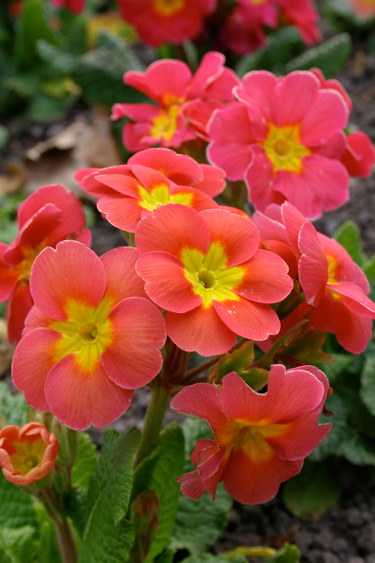
Polyanthus Coral
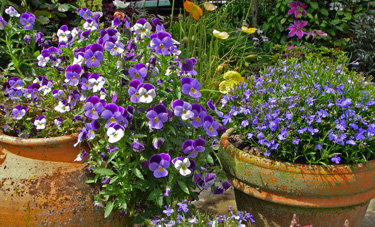
Pots of violas and lobelia
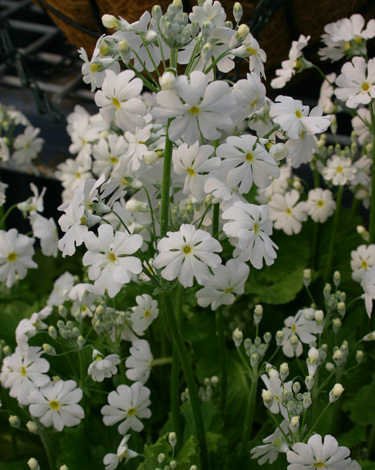
Primula malacoides
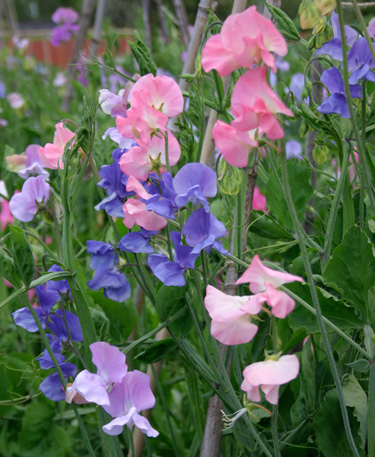
Sweet peas
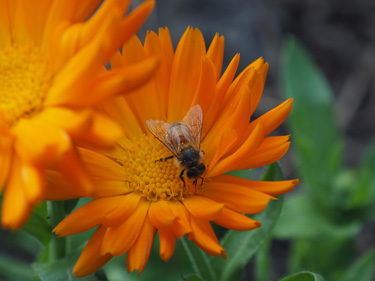
Calendula marigold
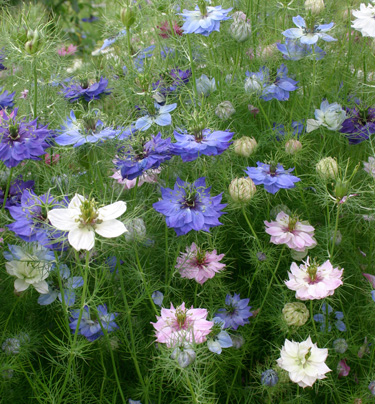
Love-in-a-Mist


